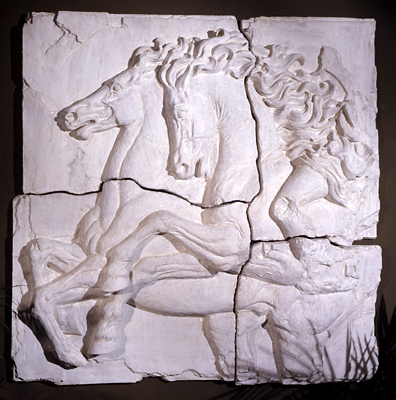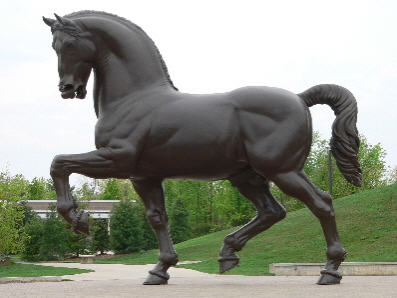The Balanced Seat

"Precise execution is not possible without the perfect collection of all these forces (the aids); suffice it to say to the horseman that he must make his own mechanism precise before trying to make the movement express something while on the horse, at the risk of speaking false to him and not being understood." Francois Baucher
Let’s just say I’ve never been known for athletic ability. Junior high and high school came and went without participation in basketball games, volleyball tournaments, or track meets. You can imagine my surprise when the high school football coach, as I was once being ribbed by my pals for my lack of grace, interjected with a straight-faced comment,“Of course she’s athletic. I’ve seen her stay on a running horse. Now that takes some skill.”
Really? Me, an athlete? I considered that he might be laying out some dry sarcasm, but….no, he really seemed to mean it. There have been many times since, when I have been attempting to do something which required motor coordination, when I have remembered his comment and wondered, could there really be an athlete in here? I considered what the coach had said. Sure, I guess it takes decent balance to stay upright, a bit of coordination to control the reins, and maybe a minimum amount of strength, to lift that saddle up there. I couldn’t help but wonder. Had I taken riding for granted? Maybe there were some practicable skills in there, and focusing on these skills could affect the quality of my riding. But what were they?
Fast forward twenty years. My children have become avid Taekwando students, practicing at our local gym. Somewhere along the way I decided to enroll myself. It just looked like too much fun to not participate. It was here that I discovered my inner athlete. Don’t kid yourself. She didn’t pop out the first night with fabulous backspins and say, “Here I am!” No. It really did not happen that way. As I recall, I spent a shameful amount of time that first winter on my butt…but then so did some of my classmates, and we were having a wonderful time ribbing each other.
Somewhere into my second season, I began to notice Her. Spending less time on the floor was my first clue, but others began to surface as time passed. I seemed to sit straighter in my chair, and run into things less often. I could walk a beam without struggling to stay on it. Moving just got…easier. I began to notice how these things affected my riding.
Let’s just say I’ve never been known for athletic ability. Junior high and high school came and went without participation in basketball games, volleyball tournaments, or track meets. You can imagine my surprise when the high school football coach, as I was once being ribbed by my pals for my lack of grace, interjected with a straight-faced comment,“Of course she’s athletic. I’ve seen her stay on a running horse. Now that takes some skill.”
Really? Me, an athlete? I considered that he might be laying out some dry sarcasm, but….no, he really seemed to mean it. There have been many times since, when I have been attempting to do something which required motor coordination, when I have remembered his comment and wondered, could there really be an athlete in here? I considered what the coach had said. Sure, I guess it takes decent balance to stay upright, a bit of coordination to control the reins, and maybe a minimum amount of strength, to lift that saddle up there. I couldn’t help but wonder. Had I taken riding for granted? Maybe there were some practicable skills in there, and focusing on these skills could affect the quality of my riding. But what were they?
Fast forward twenty years. My children have become avid Taekwando students, practicing at our local gym. Somewhere along the way I decided to enroll myself. It just looked like too much fun to not participate. It was here that I discovered my inner athlete. Don’t kid yourself. She didn’t pop out the first night with fabulous backspins and say, “Here I am!” No. It really did not happen that way. As I recall, I spent a shameful amount of time that first winter on my butt…but then so did some of my classmates, and we were having a wonderful time ribbing each other.
Somewhere into my second season, I began to notice Her. Spending less time on the floor was my first clue, but others began to surface as time passed. I seemed to sit straighter in my chair, and run into things less often. I could walk a beam without struggling to stay on it. Moving just got…easier. I began to notice how these things affected my riding.

The training produced increased control of individual body parts, and conscious awareness of balance. The patterns assigned, at each level of training, built off of previous levels. Each demands a little more precision, coordination, and control of speed and rhythm than the last. Almost unperceivably, I became aware of little things; the angle of my hip, the arch of my back, and how leaning too far one direction or the other would upset my balance and cause me to tip over. I learned to cooperate with gravity, control individual body parts independantly, and
move in a rhythmic motion, as though the pattern were set to music. All of these things were directly transferable to riding. I become more attentive to my balance in my saddle, and diligent to ensure I was not leaning this way or that. I learned to listen to the rhythm of the horse’s footsteps, and set my body motion to follow his pattern. I learned how to be still in one area of my body, while indicating an aid with another. Indeed, Taekwondo seemed to offer just the right practice for the set of skills I needed to develop to become a more precise rider.
These improvements in my posture and movement did not go unnoticed by the horses I rode. Their stride became freer, more extended, as I followed the motions better and blocked less. Twists and turns were easier to ride out, and easier to draw out of the horse, if my balance was in alignment with his. Horses become more compliant, as my rein indications were no longer contradicted by what my seat or legs were “saying” to him. This discovery was of significant value. Being able to separate and indicate the aids individually seemed to produce greater understanding and confidence in the horse. No longer did he have to guess my request from a haze of body gestures. It was clear to him, which indications were requests for which movements. As he understood my aids clearer, I soon noticed I did not need to speak to him so “loudly”, i.e., the energy of the requests diminished to nearly unperceivable amounts. It became clear to me how invisible aids might be possible, if the requests were made with precise tact. Clarity of the indications, not volume, produces a horse which responds to light aids and is compliant with the rider’s requests.
"It would be an error to believe that the study and improvement of the seat are profitable only to those horseman who desire to participate in competitions or would like to be able to train. Indeed, to be a beautiful horseman is flattering, but this is not the goal. The goal is to become a good horseman. Now one cannot be good a horseman if one is not a beautiful horseman." Jean Licart
A rider cannot afford to have a sloppy seat and aids, regardless of his discipline or purpose for riding. It is not something exclusive to those who would enter the competitive arenas. If one wishes to maintain their safety, stay upright in the saddle, and ride a horse who understands and complies with the requests being made of him, seat training is essential.
Athleticism has not come as a gift to me. It's not a natural talent. I’ve worked hard for and earned every bit of it in my possession with regular, focused practice. So can you, if you choose it.
These improvements in my posture and movement did not go unnoticed by the horses I rode. Their stride became freer, more extended, as I followed the motions better and blocked less. Twists and turns were easier to ride out, and easier to draw out of the horse, if my balance was in alignment with his. Horses become more compliant, as my rein indications were no longer contradicted by what my seat or legs were “saying” to him. This discovery was of significant value. Being able to separate and indicate the aids individually seemed to produce greater understanding and confidence in the horse. No longer did he have to guess my request from a haze of body gestures. It was clear to him, which indications were requests for which movements. As he understood my aids clearer, I soon noticed I did not need to speak to him so “loudly”, i.e., the energy of the requests diminished to nearly unperceivable amounts. It became clear to me how invisible aids might be possible, if the requests were made with precise tact. Clarity of the indications, not volume, produces a horse which responds to light aids and is compliant with the rider’s requests.
"It would be an error to believe that the study and improvement of the seat are profitable only to those horseman who desire to participate in competitions or would like to be able to train. Indeed, to be a beautiful horseman is flattering, but this is not the goal. The goal is to become a good horseman. Now one cannot be good a horseman if one is not a beautiful horseman." Jean Licart
A rider cannot afford to have a sloppy seat and aids, regardless of his discipline or purpose for riding. It is not something exclusive to those who would enter the competitive arenas. If one wishes to maintain their safety, stay upright in the saddle, and ride a horse who understands and complies with the requests being made of him, seat training is essential.
Athleticism has not come as a gift to me. It's not a natural talent. I’ve worked hard for and earned every bit of it in my possession with regular, focused practice. So can you, if you choose it.
10.14.11 TME
return to
Educated Equestrian
return to
Educated Equestrian